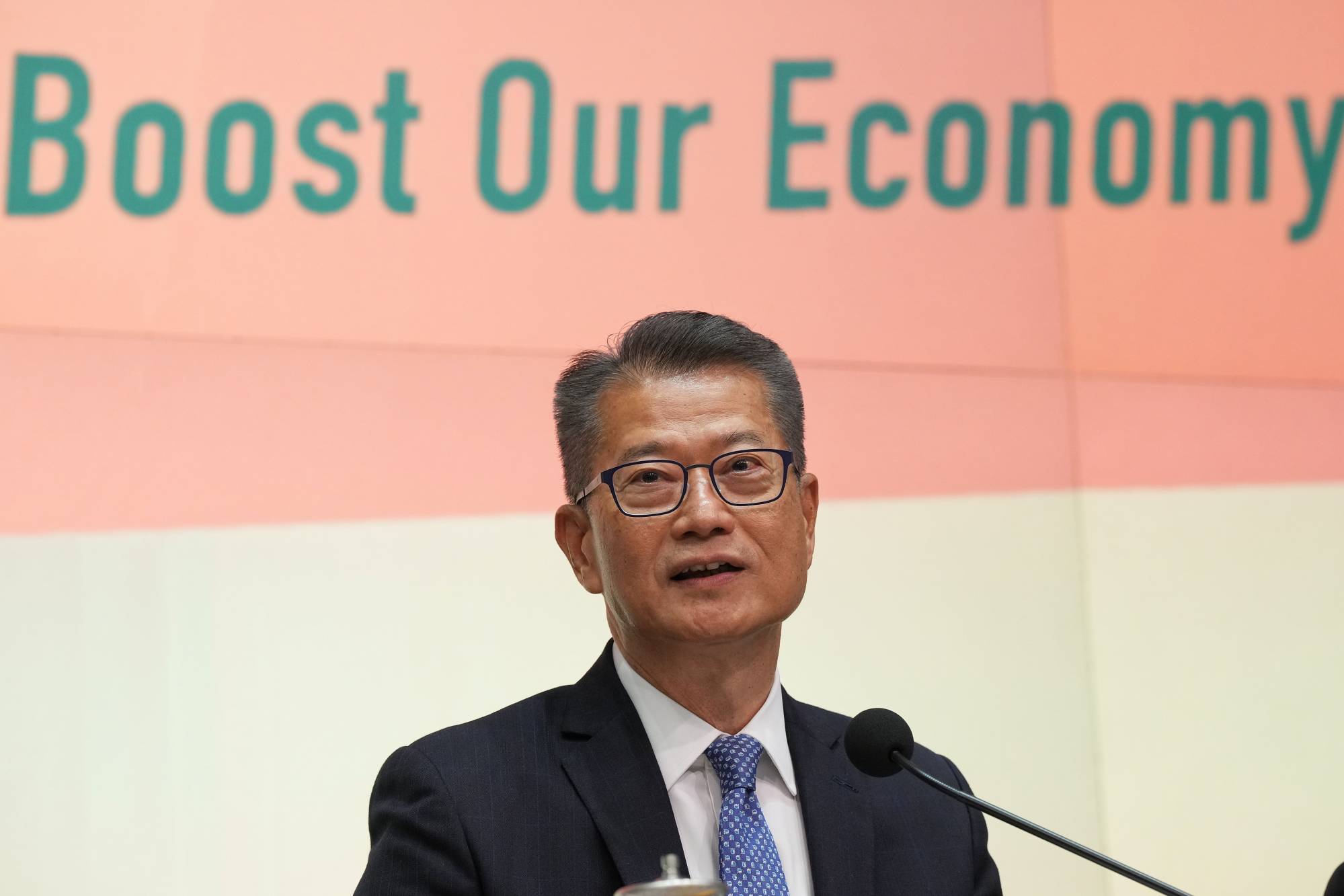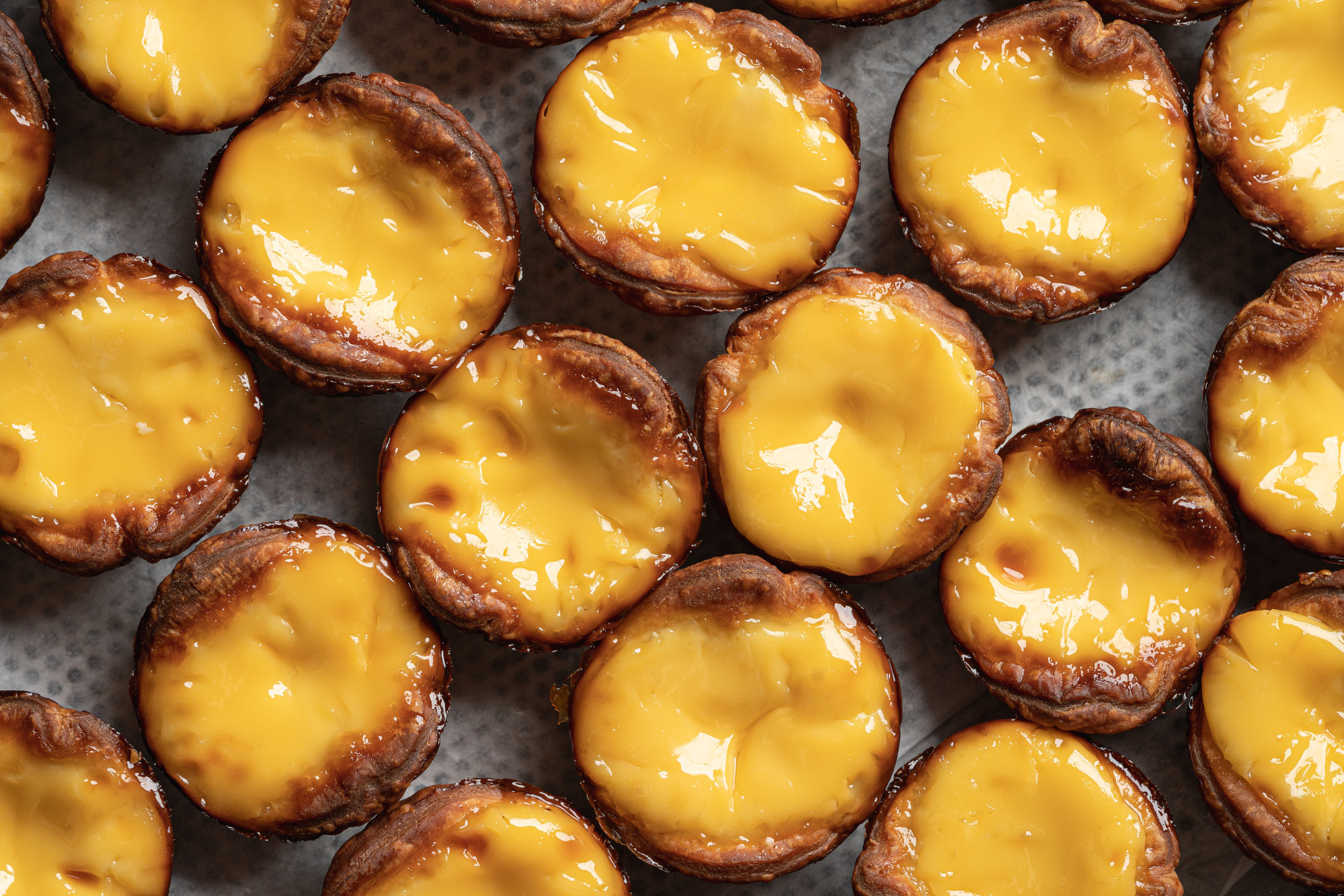
‘Shop till you drop’ is dead. Mainland Chinese tourists in Hong Kong chase Instagram-worthy photo opportunities
- Post-pandemic visitors snub usual attractions as they look for ‘Instagrammable’ hotspots, cheap eats
- Dismayed retail players realise they have to come up with new ways to attract mainland shoppers
Business is booming at Hong Kong eatery Two Greens, a small Malaysian-Cantonese fusion restaurant in Mong Kok, and the place is often packed with mainland Chinese visitors.
They have been heading there ever since Xiaohongshu – the mainland’s Instagram-like social media platform – recommended it, saying it was celebrity couple Anita Yuen Wing-yee and Julian Cheung Chi-lam’s favourite hole-in-the-wall restaurant.
“If it is good enough for Anita and Chi-lam, it’s good enough for me,” said Eva Kuang, a 25-year-old designer from Zhongshan, Guangdong province, who was lining up outside with her boyfriend.

On her first trip to Hong Kong since the Covid-19 pandemic, she headed to the restaurant which has been getting rave reviews for its bak kut teh, or braised pork ribs “tea”, and kaya toast, which is toasted bread slathered with a coconut-egg custard jam.
It is not expensive, with most items on the menu priced around HK$30 (US$4). Two Greens cannot be found in tourism books or government promotional pamphlets, but for many visitors, that is the point.
Kuang said that on previous visits with her family, she went to “all the mainstream places” like Golden Bauhinia Square and the Avenue of Stars.
“Those are places you go once and don’t feel the need to go again. Now I have the freedom to plan my own itinerary, and I want to try alternative experiences that aren’t so corny,” she said.
Kuang and her boyfriend budgeted about HK$7,000 for their three-day, two-night visit, spending most of it – HK$2,500 – on their hotel in Central. The rest was for transport, meals, tickets to museums and some basic shopping.
Hongkongers flock to Shenzhen where their dollar takes them further
Changing taste of mainland tourists
The couple exemplifies what Financial Secretary Paul Chan Mo-po described recently as changing spending patterns among mainland tourists returning to the city.
Chan said earlier this month that more mainland visitors – especially younger ones – were seeking experiences, rather than just shopping. They might even prefer cultural and arts activities, nature tours and going to concerts and exhibitions.
He said local businesses needed to refresh their offerings and products to cater to visitors’ new preferences.

Ronald Wu Keng-hou, executive director of Gray Line Tours and a Hong Kong Tourism Board member, said more visitors from the mainland wanted to experience the way locals lived, rather than go to tourist attractions.
“A lot of them have been to Hong Kong many times before the pandemic, so they are seeking alternative experiences,” he said. “They want to follow what the influencers are doing or visit districts like Sham Shui Po. It’s no longer just about shopping sprees.”
He said online shopping had become more convenient and the stronger Hong Kong dollar had taken some of the shine off shopping in the city for mainlanders.
“Instead, you see them spending the most on dining nowadays. And I’m not talking about Michelin three-star restaurants, I mean fish-ball noodles and Hong Kong-style eateries like cha chaan teng,” he added.
Can Hong Kong showcase its ‘soul’ to lure mainland Chinese tourists?
Kenny Sham Ho-ki, general manager of online travel agency Klook, said there were two groups of visitors these days.
Some, mostly from Shenzhen or Guangzhou, came on day trips or spent only one night, and usually had a purpose – to attend an event or dine at a special restaurant.
Meanwhile, a growing number were choosing to spend around three nights or more for more in-depth tours.
“If you pay attention to platforms like Xiaohongshu, some of these in-depth itineraries involve going to places like speakeasy-style cocktail bars to order a specific drink and take a picture, or visiting a ‘hidden’ restaurant,” he said.
“They also love going to all the little coffee shops that popped up during the pandemic.”
Summer slump bites hard for Hong Kong restaurants as locals, tourists change habits
Places that have become unexpectedly crowded since borders reopened range from Hong Kong-based coffee chain Arabica’s waterside outlet in Kennedy Town to bakery chain Bakehouse and even the colonial-style hallways of the University of Hong Kong’s Main Building.
The Arabica coffee shop, which opened in 2019, has been drawing visitors with its minimalistic aesthetics and its location for “Instagrammable” sunset photos by the sea.
Huang Bing, a business owner in his 40s from Shanghai, was there with his wife and two primary school-aged children early this month.
“My wife wanted to come to this spot,” he said, adding that her friends had posted about the coffee shop on WeChat, a social media platform attached to China’s biggest messaging app.
They planned to spend mainly on meals and might do some shopping if they had time, he said, “but it won’t be crazy” because of the strong Hong Kong dollar.
Hong Kong taxi drivers quote mainland Chinese tourist 3 times metered fare
Meanwhile, Yunnan student Ma Yang and two friends, all 20, were eating at McDonald's and staying at a hotel in Kwun Tong for about HK$650 a night.
The itinerary for their four-day stay consisted mostly of low-budget activities, such as visits to the museum, night walks and snacks in Mong Kok, and rides on the Star Ferry.
“It’s the summer holidays. We decided to come here because Hong Kong is safe,” Ma said.
The Bakehouse chain, meanwhile, has been attracting lines of mainlanders queuing for croissants and egg tarts, and leaving with its signature blue paper bag on their arms.
The wave of fame and popularity came as “absolutely a surprise”, said Swiss founder Gregoire Michaud, 47, who has been in the city for more than two decades.
After opening his first outlet in Wan Chai in 2018, he bucked the trend of restaurant closures through the pandemic, opening branches at four more locations from 2020 to last year.
The Michelin-star restaurant chefs growing Western dining in Shenzhen
“People needed food that could be brought home and used to make a variety of dishes. Bread as a staple and comfort food during hardship never resonated so much than during the pandemic,” he said.
When borders opened, tourists seemed to know about the chain’s popularity during the pandemic and just started showing up.
“We had no idea, and only found out that was the case when the queue became very long in Tsim Sha Tsui,” he said, adding the branch was the most popular because of its convenient location.
“We later found out we were trending on the Little Red Book app, which we had never heard of. It was all organic,” he said.

Yenn Wong, chief executive officer of global restaurant conglomerate JIA Group, said among its 12 restaurants in the city, Chinese and Asian restaurants were doing better than fine-dining ones.
Referring to mainland visitors, she said: “They want to eat good Cantonese food, that’s the number one choice. Definitely, I’ve noticed the more casual, dinky restaurants are popular with some of these tourists.”
She said the famous Kam’s Roast Goose restaurant in Wan Chai had not been so busy during the pandemic, but she had noticed queues forming as tourists wanted to get a taste of authentic Cantonese fare.
Retail industry’s great expectations fizzle
According to the Hong Kong Tourism Board, overnight visitors from the mainland spent a total of HK$97.2 billion in 2019, spending an average of HK$5,990 per person. Same-day mainland visitors spent HK$60.4 billion in total or about HK$2,198 per person.
Announcing Hong Kong’s decision to narrow its full-year economic growth forecast for 2023 from between 3.5 and 5.5 per cent to between 4 and 5 per cent, government economist Adolph Leung Wing-sing said same-day visitors’ spending had gone down “a little”, but tourism would remain the driving force for economic recovery.
Commenting on the retail industry’s lament that visitors were not spending like they used to, he said there was a clear demand and capability for consumption from locals and tourists, but the city needed to figure out how to “do better”.
“How do we make Hong Kong a more attractive place, and make sure people are willing to spend more? Perhaps by providing better service, or better value for money,” he said.

Retail sales jumped 16.9 per cent year on year to HK$33.1 billion in June, although that was still lower than the HK$35.2 billion in June 2019. There was also no noticeable jump immediately following the reopening of borders earlier this year.
Total retail sales stood at HK$36.1 billion in January, HK$33.1 billion in February, and HK$33.5 billion in March.
Adjunct professor Chan Ka-Keung of the Hong Kong University of Science and Technology’s business school, said: “The business sector’s expectation of tourists returning in droves and spending a lot on food and consumer goods did not happen.”
A survey by the Hong Kong Retail Management Association found tourists spent less in July this year, compared with the same month in 2018.
Executive director Bond Law Chen-pang said around 55 per cent of its members reported smaller purchases by visitors, with the cost of each purchase “lower by anywhere from single digits to 30 per cent”.
‘Just earn a little less’: cash-strapped mainland tourist lauds Hong Kong cabbie
“A few even reported that spending, on average, was 50 per cent lower,” he said.
Nearly 70 per cent of those surveyed reported that “overall tourism-related businesses” declined by as much as 50 per cent, with electronics, watches and jewellery, clothing, personal care products and health supplements among the hardest hit.
Law said retailers were aware of visitors’ “changed spending habits”.
“Many of us in the industry are trying to adapt and find ways to cater to this new trend,” he said.
While much attention has focused on post-pandemic visitors’ interest in the city’s neighbourhoods, one upmarket shopping centre said it had benefited from visitors’ desire for fresh experiences.
Hong Kong to host night bazaars, organise conferences to spur economy: Paul Chan
New World Development’s K11 Musea, which opened in Tsim Sha Tsui in August 2019, has seen brisk business since borders reopened.
A K11 spokesman said its business model of mixing culture with retail “provided a brand new experience to tourists and contributed to growth in footfall and sales” from mainlanders.
It was able to attract tourists with “high spending power and a penchant for luxury goods”.
The shopping centre hit record sales in March, which the spokesman said was related to events hosted there for Hong Kong Art Month, including the Art Karnival 2023 and a “City As Studio” exhibition featuring graffiti and street art.
In the first half of 2023, there was a 25 per cent increase in average spending by mainland tourists compared with before the pandemic, he said.
Additional reporting by Laura Westbrook.
